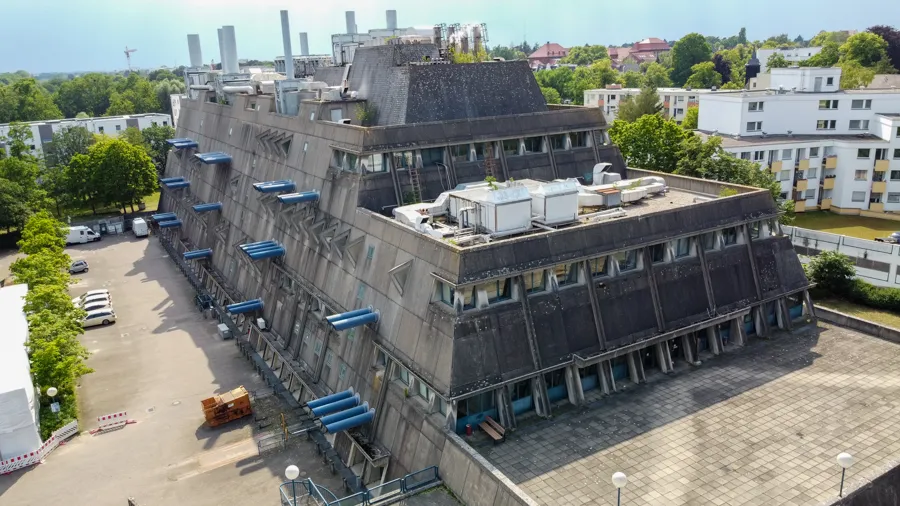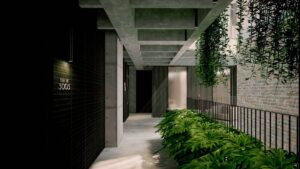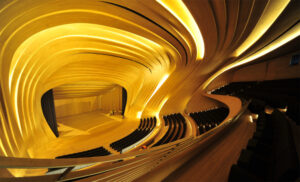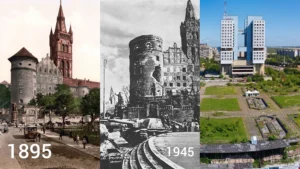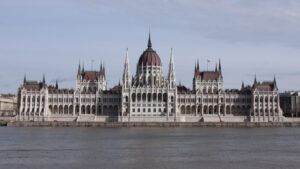Unmasking The “Concrete Monsters” In The Introduction
When people hear the word “Brutalist Architecture,” they frequently think of huge, bare, and occasionally scary concrete buildings. Few architectural forms get such strong reactions—people either admire the style’s basic honesty or hate how cold it seems. But Brutalism is more than simply bare concrete; it’s a deep philosophical and social statement that came about out of a need and a passionate belief in pure function. This contentious style was the most popular in the globe for around thirty years, and now it is going through a big cultural revival.
This definitive guide will get rid of the bias and show you the history of Brutalism, the things that make it easy to recognize, and the famous brutalist buildings that made it a part of architectural history. Get ready to see these big concrete buildings in a new way, whether you’re an architect, a history buff, or just someone who is inquisitive.
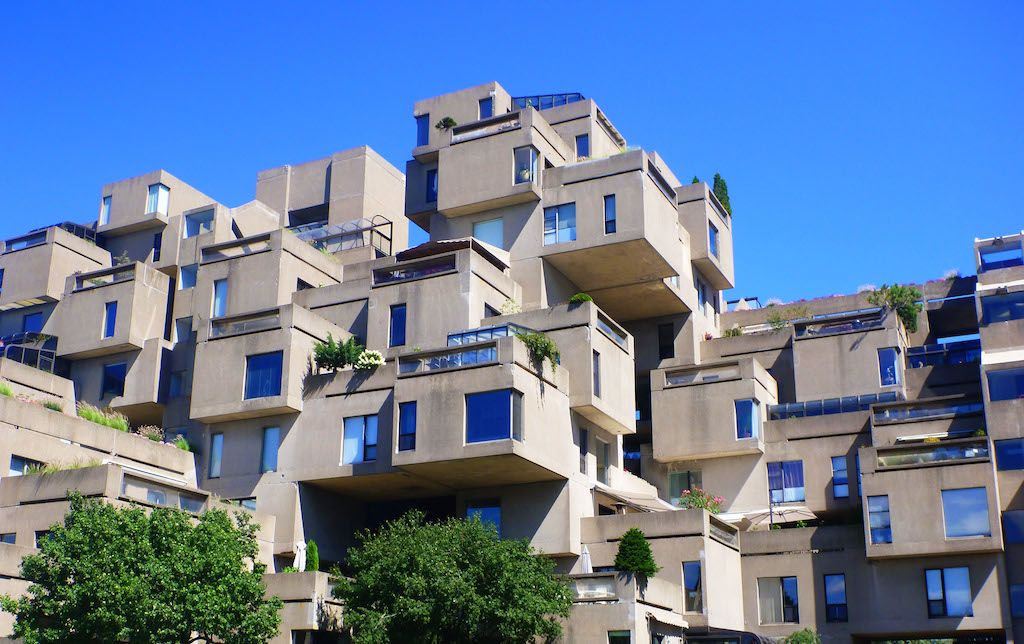
Image Source: abritandasoutherner.com
The Real Story of Brutalism: From France to the World
The word “brutal” in English has nothing to do with where Brutalist Architecture came from. The term comes from the French phrase “béton brut,” which means “raw concrete.” After World War II, Europe needed to rebuild quickly and cheaply, especially public housing, government buildings, and schools. This is when the design first appeared.
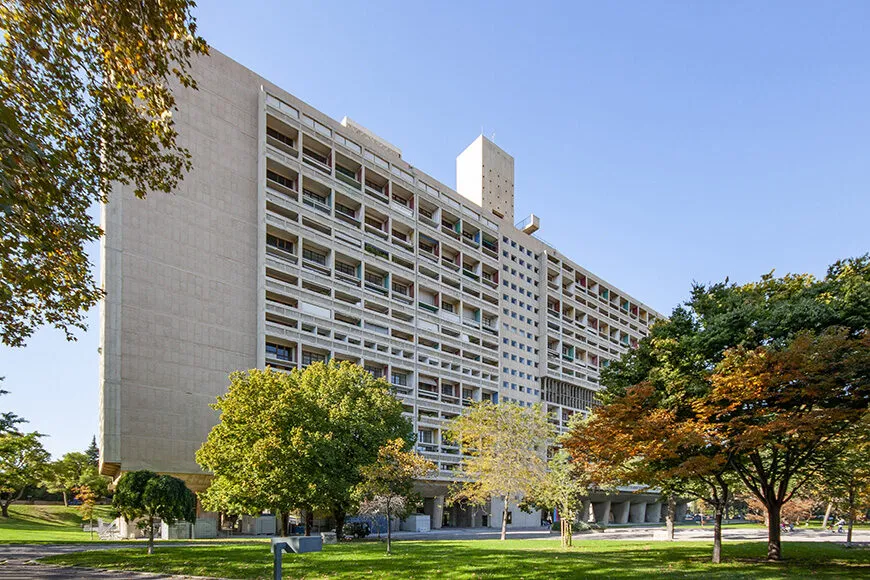
Image Source: inexhibit.com
Post-War Purpose and Philosophical Origins
Everyone agrees that the Swiss-French architect Le Corbusier was the first to start the movement. His work with exposed concrete, especially his big housing developments after World War II, was the basis for what would become Brutalism. The Unité d’Habitation in Marseille (1952), his most famous work, established the model for showing how powerful raw, unpolished concrete can be. The idea came from a strong social vision: to make “machines for living” that are accessible and useful using honest, efficient materials.
British architectural critic Reyner Banham came up with the phrase “New Brutalism” in the 1950s to describe the work of architects Alison and Peter Smithson, who designed the Hunstanton School. Banham said that the New Brutalism was based on three simple ideas: making a picture that people would remember, showing structure clearly, and using raw, unadorned materials. The movement was an ethical position against what they saw as the superficiality and adornment of earlier, more polished forms of Modernism.

North building, Salk Institute for Biological Studies designed by Louis Kahn, completed 1965 (BeyondMyKen, via wikimedia commons)
The Brutalist Blueprint Is What Makes It Unique
There is no mistaking a Brutalist building. A few basic design rules that put material honesty and raw form ahead of decorative finish give it its visual character.
Concrete That Is Not Finished And Structure That Is Not Covered
The use of béton brut is the most important thing. Architects intentionally left the concrete unfinished, leaving behind the texture of the wooden molds (formwork) that were used to cast it. This texture, which is also called shuttering markings or board-formed concrete, became an attractive feature in its own right, honoring the building process. Also, the building’s primary columns, beams, and slabs are usually shown off and celebrated instead than hidden. The finish of the structure is what it’s made of.
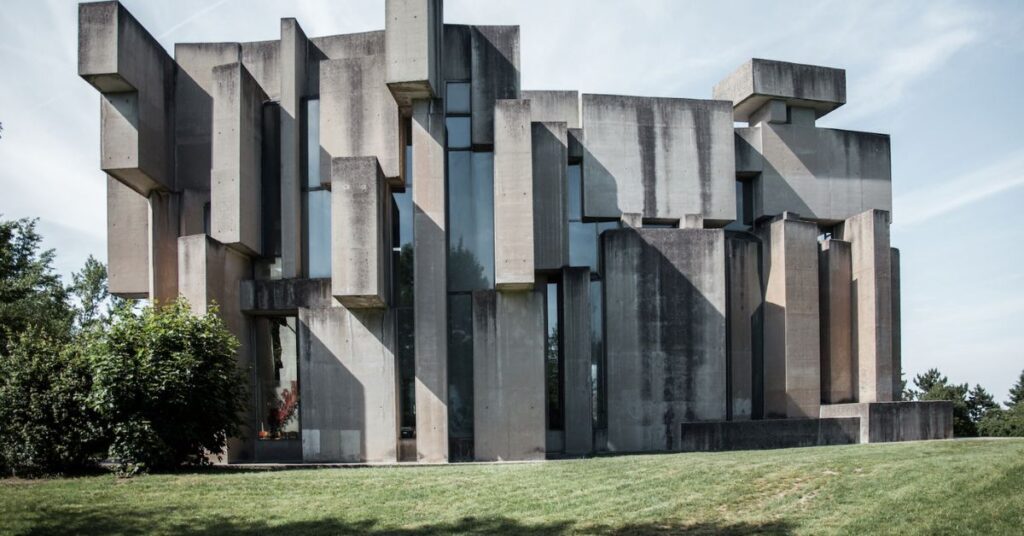
Source: /archthread.com
Forms That Are Monumental And Modular
Brutalist buildings are frequently very big, which gives them a sense of strength and stability. They usually use large, repetitive, and modular shapes, often stacking or interlocking blocks or geometric patterns in ways that are nearly sculptural. The structures were meant to look big and strong, which was appropriate for the public and institutional purposes they generally fulfilled.

Interior, The Yale Center for British Art. Louis Kahn, Architect (Scott Norsworthy, flickr).
Function Over Form
Functionality is really important. On the outside of the structure, you can often see separate, articulated volumes that show things that other styles could hide, like stairwells, elevator shafts, water tanks, and ventilation ducts. The architects’ dedication to honesty and usefulness was shown by how they made the inner workings visible. The buildings frequently have small or recessed windows compared to the huge concrete walls, which makes them look hefty and bunker-like.
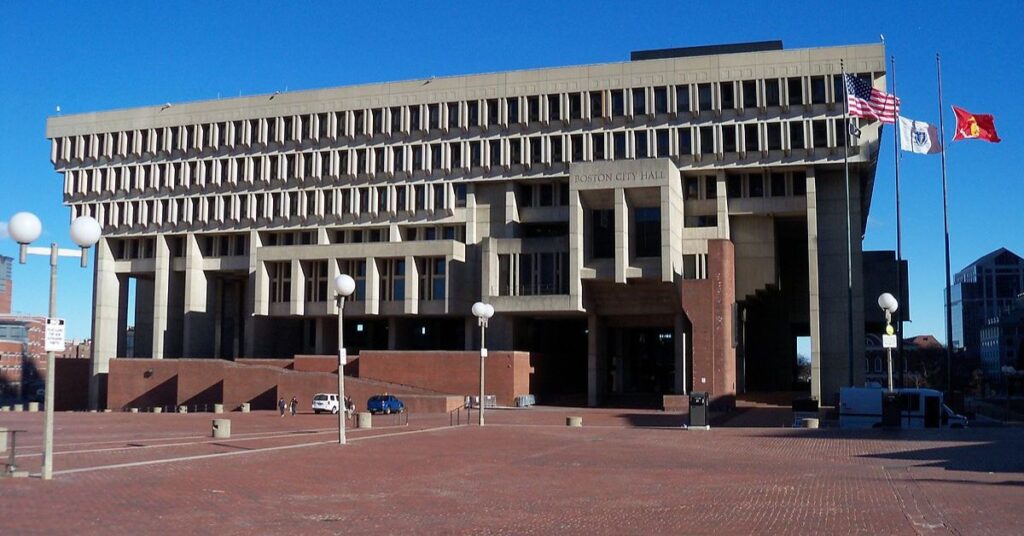
Source: /archthread.com
10 Famous Examples of Brutalist Architecture Around the World
To really get Brutalism, you need to look at some of its most iconic works. These buildings are more than just buildings; they are cultural landmarks that indicate how far the style has spread over the world.
Unité d’Habitation in Marseille, France, was built in 1952. Le Corbusier’s groundbreaking “vertical city” is a self-contained community with 337 apartments, a jogging track on the roof, and stores inside the building. It is the first and most important example of béton brut.
The Barbican Estate in London, UK, in the 1970s: This huge complex of residential towers and arts centers was designed by Chamberlin, Powell & Bon. It is the most famous example in the UK. Its rugged, bush-hammered concrete makes a strong statement about what cities wanted to do after the war.
Royal National Theatre in London, UK, 1976: Sir Denys Lasdun designed this famous building, which has stacked horizontal terraces and layered concrete shapes that make a “urban landscape” on the River Thames and let people inside.
North American Powerhouses Habitat 67 (Montreal, Canada, 1967): This experimental housing complex was designed by Moshe Safdie for Expo 67. It has 354 prefabricated, interlocking concrete boxes that show that high-density living can still give people their own gardens and space.
Boston City Hall (1968) in Boston, USA: Kallmann McKinnell & Knowles designed this controversial yet strong building, which is probably the most prominent example of American civic Brutalism. It has huge pre-cast concrete and a huge scale.
Geisel Library (San Diego, USA, 1970): William Pereira’s remarkable design for UC San Diego features eight floors of ribbed concrete that rise up to give the building a futuristic, soaring, and architecturally expressive look.
Masterpieces From Around The World And Later
The Western City Gate (Genex Tower) in Belgrade, Serbia, was built in 1977. It is a 36-story skyscraper that looks like a giant gateway. Mihajlo Mitrović designed it, and two towers are united at the top by a revolving restaurant.
The Palace of Assembly (Chandigarh, India, 1962): This building is part of Le Corbusier’s huge urban planning project. It has Brutalist shapes and environmental features like huge sun-shading brise-soleil.
Trellick Tower (London, UK, 1972): Ernő Goldfinger’s famous apartment building is easy to spot because of its tall, stark main block and separate service tower (for elevators and utilities) that are connected by aerial walkways.
Lina Bo Bardi turned an ancient drum factory in São Paulo, Brazil, into a cultural center called SESC Pompéia in 1986. She built massive, concrete-clad towers that were connected by uneven aerial bridges, showing a more expressive and late-stage Brutalism.

Source: https://unsplash.com/photos/a-very-tall-building-with-balconies-and-windows-SKwSf7-HBMw
The Brutalist Revival: Why We Can’t Get Enough Of It
Brutalism started to lose popularity in the late 1970s and 1980s. This was mostly because of changes in society and the style’s negative connection to state-sponsored public housing that occasionally went into disrepair. The concrete was supposed to be honest and raw, but it didn’t hold up well in some conditions, getting stained and dirty and looking “brutal” in the most common sense of the word.
But the 21st century has seen a huge rebirth of Brutalism. A new group of architects and design lovers like the style’s uncompromising creative purity, honesty of materials, and strong sculptural quality. Brutalism’s huge size and rough texture give a sense of permanence in a world full of digital perfection and light-weight cladding. Books like the Atlas of Brutalist Architecture have praised its proliferation over the world, and preservation campaigns are now frequent to conserve brutalist buildings that are in danger of being lost. People no longer regard the trend as just practical; they see it as a bold, artistic way to show how strong concrete is.
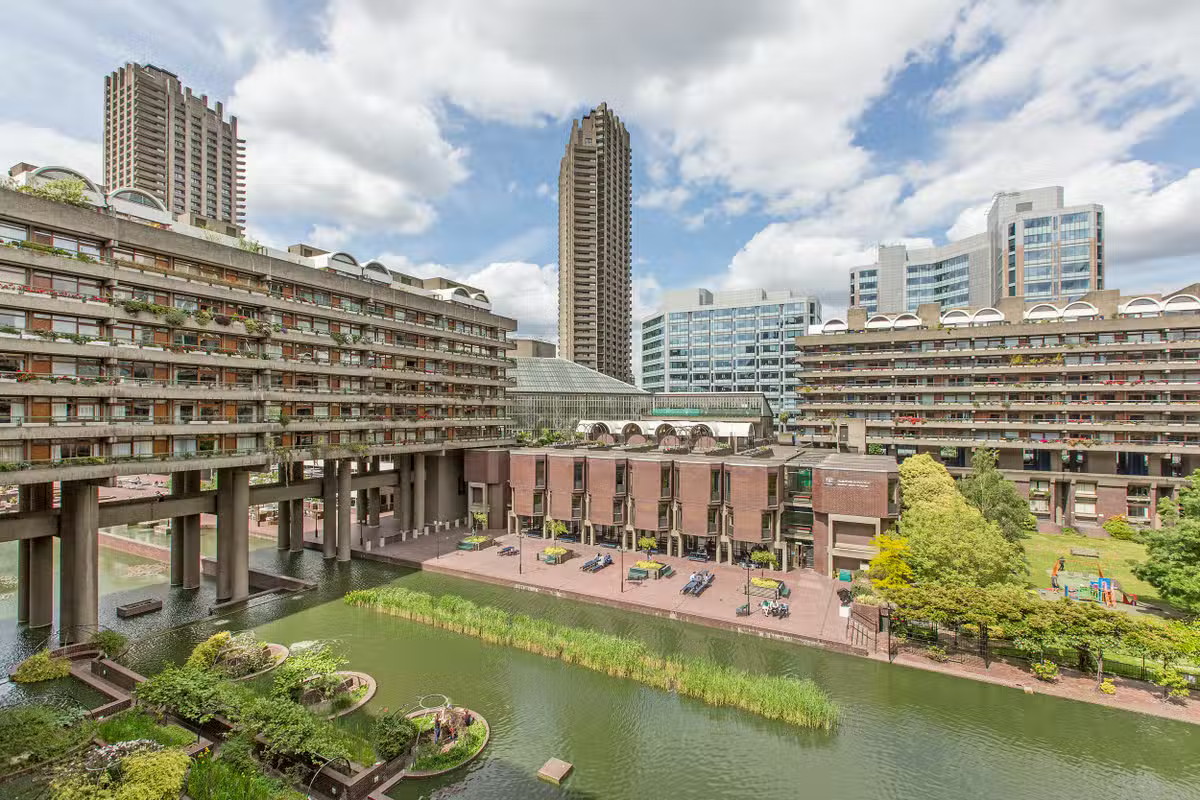
Image Source: standard.co.uk
Conclusion: A Legacy Set in Stone
Brutalist architecture is a sign of a time when people had big social goals and were honest about their money. The style has a big impact on the cityscape, from the charitable ideas behind Le Corbusier’s Unité d’Habitation to the huge size of municipal brutalist buildings like Boston City Hall. It is an architecture that stands out and doesn’t try to disguise what it is. Brutalism is becoming more and more popular as a powerful, long-lasting form of sculptural modernism, not as a mistake of the past. Take a look around your city; you might locate a gorgeous concrete monster that you can enjoy.
Reference:
Brutalist Architecture: Origins, Characteristics, and Legacy | SantaCruzArchitect.wordpress.com
Brutalist Architecture: Characteristics, Influences, Ambassadors And Sights
For more blogs CLICK HERE!!

